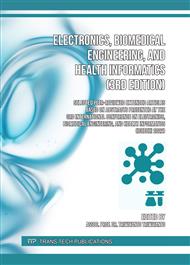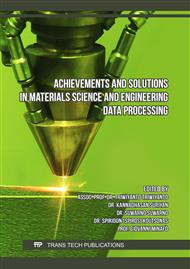[1]
B. Suhardi, M. Abdu Haq Navi, and R. Dwi Astuti, Noise level analysis to reduce noise exposure at PT. IT,, Cogent Eng., vol. 6, no. 1, 2019,.
DOI: 10.1080/23311916.2019.1666629
Google Scholar
[2]
M. Basner et al., Auditory and non-auditory effects of noise on health,, Lancet, vol. 383, no. 9925, p.1325–1332, 2014,.
DOI: 10.1016/s0140-6736(13)61613-x
Google Scholar
[3]
C. L. Themann and E. A. Masterson, Occupational noise exposure: A review of its effects, epidemiology, and impact with recommendations for reducing its burden,, J. Acoust. Soc. Am., vol. 146, no. 5, p.3879–3905, 2019,.
DOI: 10.1121/1.5134465
Google Scholar
[4]
K. Feder, D. Michaud, J. McNamee, E. Fitzpatrick, H. Davies, and T. Leroux, Prevalence of Hazardous Occupational Noise Exposure, Hearing Loss, and Hearing Protection Usage among a Representative Sample of Working Canadians,, J. Occup. Environ. Med., vol. 59, no. 1, p.92–113, 2017,.
DOI: 10.1097/jom.0000000000000920
Google Scholar
[5]
R. A. Fernandes, D. C. G. M. Vidor, and A. A. de Oliveira, The effect of noise on attention and performance in reading and writing tasks,, Codas, vol. 31, no. 4, p.2–7, 2019,.
DOI: 10.1590/2317-1782/20182017241
Google Scholar
[6]
M. J. Jafari, R. Khosrowabadi, S. Khodakarim, and F. Mohammadian, The effect of noise exposure on cognitive performance and brain activity patterns,, Open Access Maced. J. Med. Sci., vol. 7, no. 17, p.2924–2931, 2019,.
DOI: 10.3889/oamjms.2019.742
Google Scholar
[7]
S. Bottiroli, A. Rosi, R. Russo, T. Vecchi, and E. Cavallini, The cognitive effects of listening to background music on older adults: Processing speed improves with upbeat music, while memory seems to benefit from both upbeat and downbeat music,, Front. Aging Neurosci., vol. 6, no. OCT, p.1–7, 2014,.
DOI: 10.3389/fnagi.2014.00284
Google Scholar
[8]
Toomingas Allan, Occupational physiology. (2012).
Google Scholar
[9]
G. A. Boy, The handbook of human-machine interaction: A human-centered design approach,, Handb. Human-Machine Interact. A Human-Centered Des. Approach, no. April 2011, p.1–455, 2017,.
DOI: 10.1201/9781315557380-1
Google Scholar
[10]
S. Oie Kelvin et al., The Cognition and Neuroergonomics (CaN) Collaborative Technology Alliance (CTA): Scientific Vision, Approach, and Translational Paths,, no. September, p.74, (2012).
Google Scholar
[11]
M. Saadati, J. Nelson, and H. Ayaz, Convolutional neural network for hybrid fNIRS-EEG mental workload classification, vol. 953. (2020).
Google Scholar
[12]
N. H. Liu, C. Y. Chiang, and H. C. Chu, Recognizing the degree of human attention using EEG signals from mobile sensors,, Sensors (Switzerland), vol. 13, no. 8, p.10273–10286, 2013,.
DOI: 10.3390/s130810273
Google Scholar
[13]
W. . Tatum, Handbook of EEG Interpretation (2nd edition)Demos Medical Publishing: New York. (2014).
Google Scholar
[14]
C. Zhang, H. Wang, and R. Fu, Automated detection of driver fatigue based on entropy and complexity measures,, IEEE Trans. Intell. Transp. Syst., vol. 15, no. 1, p.168–177, 2014,.
DOI: 10.1109/tits.2013.2275192
Google Scholar
[15]
S. Grissmann, J. Faller, C. Scharinger, M. Spüler, and P. Gerjets, Electroencephalography based analysis of working memory load and affective valence in an N-back task with emotional stimuli,, Front. Hum. Neurosci., vol. 11, no. December, p.1–12, 2017,.
DOI: 10.3389/fnhum.2017.00616
Google Scholar
[16]
Y. Choi, M. Kim, and C. Chun, Measurement of occupants' stress based on electroencephalograms (EEG) in twelve combined environments,, Build. Environ., vol. 88, p.65–72, 2015,.
DOI: 10.1016/j.buildenv.2014.10.003
Google Scholar
[17]
M. I. Al-Kadi, M. B. I. Reaz, and M. A. Mohd Ali, Evolution of electroencephalogram signal analysis techniques during anesthesia,, Sensors (Switzerland), vol. 13, no. 5, p.6605–6635, 2013,.
DOI: 10.3390/s130506605
Google Scholar
[18]
A. Tandle, N. Jog, A. Dharmadhikari, and S. Jaiswal, Estimation of valence of emotion from musically stimulated EEG using frontal theta asymmetry,, 2016 12th Int. Conf. Nat. Comput. Fuzzy Syst. Knowl. Discov. ICNC-FSKD 2016, p.63–68, 2016,.
DOI: 10.1109/fskd.2016.7603152
Google Scholar
[19]
J. E. M. Sabine J. Schlittmeier1, Review of research on the effects of noise on cognitive performance 2017-2021,, Icben 2021, p.16, (2021).
Google Scholar
[20]
A. Shoka, M. Dessouky, A. El-Sherbeny, and A. El-Sayed, Literature Review on EEG Preprocessing, Feature Extraction, and Classifications Techniques,, Menoufia J. Electron. Eng. Res., vol. 28, no. 1, p.292–299, 2019,.
DOI: 10.21608/mjeer.2019.64927
Google Scholar
[21]
D. C. A. S. U. Montgomery, Design and Analysis of Experiments Ninth Edition John Wiley & Sons, Arizona State University. (2017).
Google Scholar
[22]
J. Ke, J. Du, and X. Luo, The effect of noise content and level on cognitive performance measured by electroencephalography (EEG),, Autom. Constr., vol. 130, Oct. 2021,.
DOI: 10.1016/j.autcon.2021.103836
Google Scholar
[23]
A. M. Abbasi, M. Motamedzade, M. Aliabadi, R. Golmohammadi, and L. Tapak, Study of the physiological and mental health effects caused by exposure to low-frequency noise in a simulated control room,, Build. Acoust., vol. 25, no. 3, p.233–248, 2018,.
DOI: 10.1177/1351010x18779518
Google Scholar
[24]
L. N. Huda, C. Salsabila, and I. Nasution, The Effect of Noise on Average Beta EEG Signal,, 2021 5th Int. Conf. Electr. Telecommun. Comput. Eng. ELTICOM 2021 - Proc., p.100–106, 2021,.
DOI: 10.1109/elticom53303.2021.9590112
Google Scholar
[25]
J. C. Bore et al., Sparse EEG Source Localization Using LAPPS: Least Absolute l-P (0<p<1) Penalized Solution,, IEEE Trans. Biomed. Eng., vol. 66, no. 7, p.1927–1939, 2019,.
DOI: 10.1109/tbme.2018.2881092
Google Scholar
[26]
M. X. Cohen, Analyzing Neural Time Series Data. (2019).
Google Scholar
[27]
Anke Meyer Baese, AND SIGNAL ANALYSIS IN MEDICAL IMAGING SECOND EDITION P attern R ecognition AND SIGNAL ANALYSIS IN MEDICAL IMAGING. Academic Press is an imprint of Elsevier The Boulevard, Langford Lane, Kidlington, Oxford, (2014).
Google Scholar
[28]
Z. Khakim and S. Kusrohmaniah, Electroencephalography (EEG) Fundamentals for Psychological Research,, Psychol. Bull., vol. 29, no. 1, p.92, 2021,.
Google Scholar
[29]
T. R. Mullen et al., Real-time neuroimaging and cognitive monitoring using wearable dry EEG,, IEEE Trans. Biomed. Eng., vol. 62, no. 11, p.2553–2567, 2015,.
DOI: 10.1109/tbme.2015.2481482
Google Scholar
[30]
T. Tamesue, H. Kamijo, and K. Itoh, Quantitative evaluation using EEG for influence of meaningful or meaningless noise on participants during mental tasks,, 6th Int. Conf. Soft Comput. Intell. Syst. 13th Int. Symp. Adv. Intell. Syst. SCIS/ISIS 2012, p.2120–2123, 2012,.
DOI: 10.1109/scis-isis.2012.6505321
Google Scholar
[31]
Y. Yoshida, T. Kawana, E. Hoshino, Y. Minagawa, and N. Miki, Capturing human perceptual and cognitive activities via event-related potentials measured with candle-like dry microneedle electrodes,, Micromachines, vol. 11, no. 6, 2020,.
DOI: 10.3390/mi11060556
Google Scholar
[32]
T. Triwiyanto, T. Rahmawati, P. I. P. Alit, and M. E. E. Hikaristiana, Investigation of Electrode Location to Improve the Accuracy of Wearable Hand Exoskeleton Trainer Based on Electromyography., Journal of Biomimetics, Biomaterials and Biomedical Engineering, 2021,.
DOI: 10.4028/p-y7g473
Google Scholar
[33]
J. L. Kästle, B. Anvari, J. Krol, and H. A. Wurdemann, Correlation between Situational Awareness and EEG signals,, Neurocomputing, vol. 432, p.70–79, 2021,.
DOI: 10.1016/j.neucom.2020.12.026
Google Scholar
[34]
A. Arsalan, M. Majid, A. R. Butt, and S. M. Anwar, Classification of Perceived Mental Stress Using A Commercially Available EEG Headband,, IEEE J. Biomed. Heal. Informatics, vol. 23, no. 6, p.2257–2264, 2019,.
DOI: 10.1109/jbhi.2019.2926407
Google Scholar
[35]
M. U. Iqbal, B. Srinivasan, and R. Srinivasan, Dynamic assessment of control room operator's cognitive workload using Electroencephalography (EEG),, Comput. Chem. Eng., vol. 141, p.106726, 2020,.
DOI: 10.1016/j.compchemeng.2020.106726
Google Scholar
[36]
A. M. Abbasi, M. Motamedzade, M. Aliabadi, R. Golmohammadi, and L. Tapak, Combined effects of noise and air temperature on human neurophysiological responses in a simulated indoor environment,, Appl. Ergon., vol. 88, no. June, p.103189, 2020,.
DOI: 10.1016/j.apergo.2020.103189
Google Scholar
[37]
K. Pieper et al., Working With Environmental Noise and Noise-Cancelation: A Workload Assessment With EEG and Subjective Measures,, Front. Neurosci., vol. 15, no. November, p.1–13, 2021,.
DOI: 10.3389/fnins.2021.771533
Google Scholar
[38]
Z. Wang, Y. Zheng, D. C. Zhu, A. C. Bozoki, and T. Li, Classification of Alzheimer's disease, mild cognitive impairment and normal control subjects using resting-state fmri based network connectivity analysis,, IEEE J. Transl. Eng. Heal. Med., vol. 6, no. March, p.1–9, 2018,.
DOI: 10.1109/jtehm.2018.2874887
Google Scholar
[39]
B. Tokhmechi, R. Fazel-Rezai, and M. Bamdad, The effects of explosion sound on the brain based on electroencephalogram signals,, Int. J. Environ. Health Res., vol. 30, no. 5, p.475–491, 2020,.
DOI: 10.1080/09603123.2019.1599326
Google Scholar
[40]
S. S. Daud and R. Sudirman, Effect of white noise stimulation and visual working memory task on brain signal,, ARPN J. Eng. Appl. Sci., vol. 10, no. 18, p.8491–8499, (2015).
Google Scholar
[41]
P. Zarjam, J. Epps, and N. H. Lovell, Beyond Subjective Self-Rating: EEG Signal Classification of Cognitive Workload,, IEEE Trans. Auton. Ment. Dev., vol. 7, no. 4, p.301–310, 2015,.
DOI: 10.1109/tamd.2015.2441960
Google Scholar
[42]
L. H. Tseng, M. T. Cheng, S. T. Chen, J. F. Hwang, C. J. Chen, and C. Y. Chou, An EEG investigation of the impact of noise on attention,, Adv. Mater. Res., vol. 779, p.1731–1736, 2013,.
DOI: 10.4028/www.scientific.net/amr.779-780.1731
Google Scholar
[43]
P. Putman, B. Verkuil, E. Arias-Garcia, I. Pantazi, and C. Van Schie, EEG theta/beta ratio as a potential biomarker for attentional control and resilience against deleterious effects of stress on attention,, Cogn. Affect. Behav. Neurosci., vol. 14, no. 2, p.782–791, 2014,.
DOI: 10.3758/s13415-013-0238-7
Google Scholar
[44]
X. Qin, J. Deng, M. Wang, P. Wang, L. Wang, and Y. Zhang, Eeg feature extraction and recognition with different mental states based on wavelet transform and accln network,, J. Technol., vol. 32, no. 4, p.261–274, (2017).
DOI: 10.20944/preprints201610.0075.v1
Google Scholar
[45]
M. Sadeghian, Z. Mohammadi, and S. M. Mousavi, Investigation of electroencephalography variations of mental workload in the exposure of the psychoacoustic in both male and female groups,, Cogn. Neurodyn., no. November 2021, 2021,.
DOI: 10.1007/s11571-021-09737-3
Google Scholar
[46]
G. Jun and K. G. Smitha, EEG based stress level identification,, 2016 IEEE Int. Conf. Syst. Man, Cybern. SMC 2016 - Conf. Proc., p.3270–3274, 2017,.
DOI: 10.1109/smc.2016.7844738
Google Scholar
[47]
H. Jebelli, S. Hwang, and S. H. Lee, EEG-based workers' stress recognition at construction sites,, Autom. Constr., vol. 93, no. January, p.315–324, 2018,.
DOI: 10.1016/j.autcon.2018.05.027
Google Scholar
[48]
M. Sadeghian et al., Effect of tonal noise and task difficulty on electroencephalography and cognitive performance,, Int. J. Occup. Saf. Ergon., vol. 0, no. 0, p.1–9, 2021,.
Google Scholar
[49]
K. Kato, S. Yasukawa, K. Suzuki, and A. Ishikawa, Oscillatory neural activity during performance of a cognitive task in the presence of fluctuating ambient noise,, IEICE Trans. Inf. Syst., vol. E100D, no. 1, p.181–189, 2017,.
DOI: 10.1587/transinf.2016edp7300
Google Scholar
[50]
P. Nassiri et al., The interactive effect of industrial noise type, level and frequency characteristics on occupational skills,, Perform. Enhanc. Heal., vol. 3, no. 2, p.61–65, 2014,.
Google Scholar
[51]
R. Golmohammadi, E. Darvishi, J. Faradmal, J. Poorolajal, and M. Aliabadi, Attention and short-term memory during occupational noise exposure considering task difficulty,, Appl. Acoust., vol. 158, p.107065, 2020,.
DOI: 10.1016/j.apacoust.2019.107065
Google Scholar



